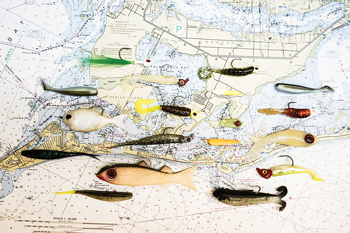Make it a point - get hooked on jigs

rusty chinnis | sun
Just a few of the many jigs available to the angler today.
If I had only one lure in my tackle box it would be a jig. The jig is one of the oldest and most effective lures ever made, which explains why they have a prominent place in most anglers’ arsenals. Today’s jigs come in a breath taking array of shapes, sizes and colors with holographic patterns and live bait scents.
And while there have been many advancements in design, the basic jig with a lead head and buck tail body is still the go to lure for many anglers. That’s because if you have faith in the lure and vary the action, it's possible to elicit a strike from any game fish (fresh or salt) that swims local waters.
Jigs are often used half-heartedly by anglers who substitute them for live bait. If you take the time to really give them a chance, you’ll find that they will often out perform live bait. This may be hard to believe, but consider the facts. First you gain an advantage by not having to catch or keep live bait. In addition you don't have to constantly re-bait a hook, and you can cast and retrieve continuously, covering a greater area.
While you’ll vary your retrieve given the situation and fish you’re targeting, in general the best presentation is made by allowing the lure to sink completely to the bottom. Using a slow retrieve, bounce the jig across the bottom.
This method is effective for a large majority of species including trout, redfish, grouper, tarpon, flounder and snook. A fast, jerky retrieve will produce better results on Spanish mackerel, jacks, bluefish and ladyfish.
When fished properly, the retrieve should be smooth and effortless. Hold the rod at about a 45-degree angle to the water, imparting action with the wrist and forearm. Don't allow much slack to form on the retrieve, as most strikes happen on the drop. Watch the line closely, and you’ll know the jig is on the bottom when the line goes slack.
With practice, the retrieve will become second nature. Since you’ll get lots of hits on the slack line fall, a sharp hook will greatly improve your odds. Sharpen your hooks before you start fishing and check them often, especially when fishing structure like rocks and oyster beds.
One of the most productive areas to fish jigs is on and around the grass beds that carpet the bay. Make repeated casts in a 180 degree arc with about 10 feet between casts. This will allow you to cover a lot of water. Make casts to sand holes and the edges of slues. Cast beyond holes and then let the jig bounce across the sandy bottom. Start at one end of the hole in the grass and then make the same spaced casts across its width to completely cover the pothole. On the edges of grass flats and slues try casting parallel to and just off the grass edge.
Another excellent area to fish jigs is along the beaches, right up against the shore break and around any structure. Species like flounder, permit and pompano often key in on the puffs of sand that jigs produce when they strike the bottom. When you find obstructions such as limestone, rock groins or jetties, work the edges carefully.
The best spinning and bait casting outfits for jigging have a tip that can telegraph a subtle strike and enough backbone to set the hook. Jigs will take 100-pound tarpon, 20-pound snook or 2-pound trout, so line and leader should be rigged accordingly. When fishing the bay an 8-10 pound outfit with a smooth, properly set drag is perfect.
Rig by doubling the standing line using a Bimini Twist or Spider Hitch and then attach about a 12-inch leader (20-40 pound) using a surgeon’s or uni-knot. A small swivel can also be used to make the attachment from standing line to leader. Attaching the leader to the jig with a loop knot will improve the action and the hook-up ratio. The non-slip mono loop is the best knot for the job. If you don’t know how to tie these knots there are lots of instructional videos available online.
Like other lures, there are a vast number of jig types to choose from. All of them can be effective, but color may be the most important characteristic. Scientists have discovered that fish can better locate darker colors in cloudy water and a light or clear color in clear water. Tailor the color of the jig to that of the water.
If you haven’t discovered the magic of jigs, you’ll find them efficient, inexpensive, and very effective. Test them on your favorite fish, and I’m guessing you’ll soon be hooked on jigs.

